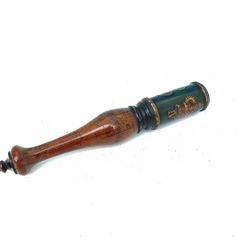Annotation:Tipstaff Strathspey: Difference between revisions
No edit summary |
No edit summary |
||
| (6 intermediate revisions by the same user not shown) | |||
| Line 1: | Line 1: | ||
{{TuneAnnotation | {{TuneAnnotation | ||
| | |f_annotation=[[File:Tipstaff.jpg|240px|right|thumb|A 19th century ceremonial tipstaff.]]'''TIPSTAFF STRATHSPEY'''. AKA - "The Tipp Staf." English, Scottish; Strathspey or Reel (whole or cut time). G Major. Standard tuning (fiddle). AB. The "Tipstaff Strathspey" appears in the 1790 collection by Kirkmichael, Perthshire, fiddler [[biography:Robert Petrie]] (1767-1830). The Tipstaff was is an officer of the court, sometimes with the duties of a clerk, who carries a symbolic rod, the ''tipstaff'', representing the authority of the tipstaff or other officials. The name was derived from an actual rod or staff carried by early law enforcement officers who used it to arrest miscreants, using a wooden or metal staff or stave as both protection and an object of force. The stave had a metal head that could be unscrewed, in which the warrant detailing the authority of the wielder was kept. The policeman's "persuader" nightstick or, currently, baton, is a derivative of the tipstaff. | ||
| | |||
<br> | <br> | ||
<br> | <br> | ||
The tune does not seem to have been reprinted in other music publications, however, a version can be found as “The Tipp Staf” in the large 1770 music manuscript collection of Northumbrian musician William Vickers, about whom, unfortunately, nothing is known. Vickers’ version was entered without the dotted strathspey rhythms of Petrie's version. Another manuscript version was contained in London musician Thomas Hammersley's c. 1790 music copybook as simply "Tipstaff." "Tipstaff Strathspey" is often attributed to Petrie, but the the dates of the Vickers ms. do not support this, as the fiddler-composer would have been aged three at the time. | |||
|f_source_for_notated_version= | |f_source_for_notated_version=William Vickers 1770 music manuscript collection (Northumberland) [Seattle]. | ||
|f_printed_sources=Petrie ('''Collection of Strathspey Reels and Country Dances'''), 1790; p. 3. | |f_printed_sources=Petrie ('''Collection of Strathspey Reels and Country Dances'''), 1790; p. 3. Seattle ('''Great Northern Tune Book/William Vickers'''), 2008; No. 18, pp. 16-17. | ||
| | |f_tune_annotation_title=https://tunearch.org/wiki/Annotation:Tipstaff_Strathspey > | ||
}} | }} | ||
------------ | |||
Latest revision as of 00:50, 23 January 2022
X:1 T:Tipstaff Strathspey C:Robert Petrie (?) S:Petrie's Collection of Strathspey Reels and Country Dances &c., 1790 Z:Steve Wyrick <sjwyrick'at'astound'dot'net>, 3/5/04 N:Petrie's First Collection, page 3 L:1/8 M:C R:Strathspey K:G c | B<Gg>G DG-GA/B/ | c<Aa>A EA-A.c | dB-Bd ec-ce | g>dTc>B (TB2A>)c | BGgG D(G G)A/B/ | cAaA EA-Ac | Bg-ge (f/e/f/g/) ag | fd f/e/d/^c/ dDd || d | (d<=f)(Tf>e) (Ted)(Tdc) | cBA^G A2 A,A/B/ | c<eTe>d d>cB<d | g<dTc>B TB2Az | G,<G-TG>B A,<ATA>c | B,<TBB>d C<Tc-c>e | B>de>f g>dTc>B | TA>GA<B G2 G,2 |]

The tune does not seem to have been reprinted in other music publications, however, a version can be found as “The Tipp Staf” in the large 1770 music manuscript collection of Northumbrian musician William Vickers, about whom, unfortunately, nothing is known. Vickers’ version was entered without the dotted strathspey rhythms of Petrie's version. Another manuscript version was contained in London musician Thomas Hammersley's c. 1790 music copybook as simply "Tipstaff." "Tipstaff Strathspey" is often attributed to Petrie, but the the dates of the Vickers ms. do not support this, as the fiddler-composer would have been aged three at the time.

